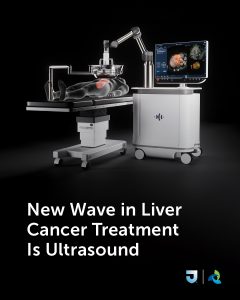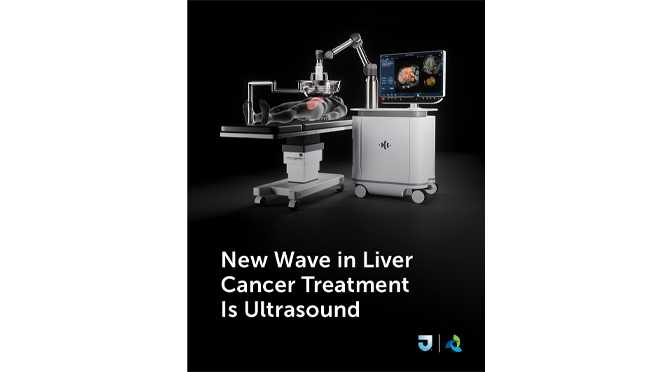LVHN’s first patient being treated this week
 Lehigh Valley, Pa. (March 12, 2025) – A constant in medicine is finding ways to make medical and surgical treatment shorter and less complicated. A big step in that direction is the addition of histotripsy at Lehigh Valley Topper Cancer Institute for treating cancerous liver tumors. Lehigh Valley Health Network (LVHN), part of Jefferson Health, is the first and only health network in Pennsylvania to offer this innovative treatment, and its first procedure is being conducted this week.
Lehigh Valley, Pa. (March 12, 2025) – A constant in medicine is finding ways to make medical and surgical treatment shorter and less complicated. A big step in that direction is the addition of histotripsy at Lehigh Valley Topper Cancer Institute for treating cancerous liver tumors. Lehigh Valley Health Network (LVHN), part of Jefferson Health, is the first and only health network in Pennsylvania to offer this innovative treatment, and its first procedure is being conducted this week.
The next closest locations for histotripsy, approved by the U.S. Food and Drug Administration in late 2023, are in Camden, N.J., and Rochester, N.Y.
What is histotripsy?
Histotripsy is a noninvasive, nonionizing and nonthermal procedure. Using computed tomography and ultrasound guidance, hyper-focused sound waves are delivered through the body to the liver lesion. The sound waves mechanically destroy the tumor while sparing normal tissue. The technology allows physicians to treat liver cancer without surgery, pain, incisions or radiation.
“Using focused ultrasound waves, this method breaks down the cancerous tissue without harming adjacent healthy tissues,” says hematologist oncologist Maged Khalil, MD, with the Cancer Institute. “It can be applied to various types of tumors, including those in the liver, kidney and other organs.”
Histotripsy is an outpatient, single-session treatment with minimal interference to the patient’s life. A wand outside the body is used to conduct it. As a result, recovery is fast and easy. Histotripsy typically results in fewer side effects and complications than more invasive treatments, improving the overall patient experience – particularly for those who are unable to withstand surgery or other invasive interventions to the liver.
More benefits of histotripsy
LVHN clinicians are applauding the benefits now available to certain cancer patients.
“I have been treating cancer for over 20 years, and histotripsy is the most incredible, innovative therapy I have performed,” says Errin Hoffman, MD, Section Chief, Vascular and Interventional Radiology at LVHN. “Given the ability to precisely target lesions, there is minimal collateral damage or injury to the liver. Therefore, if new lesions develop, retreatment can be performed without risk of liver injury.”
An added benefit of histotripsy is the potential “abscopal effect,” also called off-target treatment. During the treatment, tumors are liquefied, resulting in release of tumor antigens. This generates an immune response in which the body attacks and destroys tumors located elsewhere in the body.
Another benefit is that histotripsy will not interfere with the patient’s overall oncologic treatment plan. Unlike other liver-directed therapies, it is not necessary to discontinue chemotherapy or blood thinners prior to treatment. This allows seamless, uninterrupted treatment, reducing the risk of disease progression. “I am thrilled that we can offer this leading-edge treatment to the Lehigh Valley. Histotripsy is a game changer,” Dr. Hoffman says.
How to get histotripsy treatment
Nonsurgical treatments available at the Cancer Institute for cancerous tumors of the liver include ablation (using a needle to deliver energy to destroy tumors) and embolization (using catheters and wires to block blood flow or deliver therapy to tumors). Histotripsy is the least invasive of them; however, the technology is not appropriate for all patients.
As with the process with other liver-directed therapies, medical oncologists, surgical oncologists, transplant surgery, hepatology and urology provide referrals for histotripsy. You can also self-refer. In this case, the treatment and its benefits will be discussed with you in detail. To do this, call 835-210-4607 or visit LVHN.org/histotripsy.
“Histotripsy represents a breakthrough advancement in cancer treatment through its noninvasive technology,” says Dr. Khalil. “It allows effective tumor management with reduced recovery times, minimized side effects and the potential for improved immune responses. With histotripsy integrated into our treatment options, patients have more personalized care that prioritizes their health and well-being, enhancing overall treatment outcomes and quality of life.”
On the horizon
FDA approval for treatment of renal, pancreatic and prostate cancer is expected in the not-too-distant future. As histotripsy technology advances, indications for treatment will also increase.
About Jefferson
Lehigh Valley Health Network is now proudly part of Jefferson Health. Nationally ranked, Jefferson, which is principally located in the Greater Philadelphia region, Lehigh Valley and northeastern Pennsylvania and southern New Jersey, is reimagining health care and higher education to create unparalleled value. Jefferson is more than 65,000 people strong, dedicated to providing the highest-quality, compassionate clinical care for patients; making our communities healthier and stronger; preparing tomorrow’s professional leaders for 21st-century careers; and creating new knowledge through basic/programmatic, clinical and applied research. Thomas Jefferson University, home of Sidney Kimmel Medical College, Jefferson College of Nursing, and the Kanbar College of Design, Engineering and Commerce, dates back to 1824 and today comprises 10 colleges and three schools offering 200+ undergraduate and graduate programs to more than 8,300 students. Jefferson Health, nationally ranked as one of the top 15 not-for-profit health care systems in the country and the largest provider in the Philadelphia and Lehigh Valley areas, serves patients through millions of encounters each year at 32 hospitals and more than 700 outpatient and urgent care locations throughout the region. Jefferson Health Plans is a not-for-profit managed health care organization providing a broad range of health coverage options in Pennsylvania and New Jersey for more than 35 years.
Information provided to TVL by:
Priscilla Turbitt




